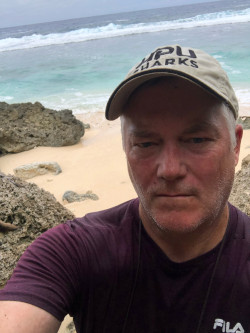Brenden Holland PH.D.
College of Natural and Computational Sciences - Department of Natural Science
Associate Professor of Biology
Education:
- Postdoctoral Fellow, Kewalo Marine Lab
- PhD in Biological Oceanography Texas A&M University
- MS in Biological Oceanography, Texas A&M University
- BA in Biological Science, University of California at San Diego
Professional Interests:
Conservation Biology, Biological Invasions, Molecular Ecology, Phylogeography, Phylogenetics, Island Biogeography, Oceanography, STEM Education
Research Statement
The Pacific Islands might be considered an environmental microcosm of what is occurring on a global scale. Lessons learned in places like Hawaii, and solutions derived from ecological studies here have direct relevance to the world at large. Hawaii and other islands of the Pacific house sensitive native marine and forest ecosystems that provide critical nutrient, economic, air and water services for human populations. Native terrestrial species such as the achatinelline tree snails require native host trees for their survival, and are sensitive to the presence of established invasive species including plants, insects such as ants, predatory snails, rats, and African chameleons. Therefore forests where tree snails are present can be deemed high priority areas for focused conservation effort, as tree snails are important indicators of ecosystem health. Human populations rely directly on native rain forest for water services, as intact forest ecosystems act as upland reservoirs, capturing and slowly releasing clean water. Hawaii is notorious for its absence of native terrestrial vertebrate lineages (with the exception of birds and a single bat species), there are no native land dwelling mammals, reptiles, or amphibians. However, since the late 19th century, humans have released at least 43 species of frogs, toads lizards, and turtles, more than 2 dozen of which are currently established, and all of these are predatory. Amazingly, very few studies had been conducted aimed at understanding behaviors and determining the impact of invasive reptiles and amphibians (herpetofauna) on native ecosystems, until Dr. Brenden Holland began to investigate the ecology of those species that have ranges which overlap with native forest.
Summaries of a selection of published ecological and conservation biology studies conducted by Dr. Holland and his research group in recent years include:
1.) The first study demonstrating that the devastating predatory snail Euglandina rosea shows a preference for tracking the slime trail of native tree snails versus the intended target agricultural pest species, the giant African snail (Achatina fulica) (Holland et al. 2012).
2.) The first study showing that newly hatched wolf snails are predatory and can feed on prey snails more than three times their own body mass (Sugiura et al. 2011).
3.) The first detection of impacts of Jackson’s chameleons on endemic fauna, including the endangered Oahu tree snail Achatinella mustelina (Holland, Costello & Montgomery 2010)
4.) Detailed impact projections, estimates and long term threat assessment via observed predatory density, gut content analyses and ingestion frequency (Chiaverano & Holland 2014).
5.) Characterization of Chameleon movement behavior and establishment of home range in various forest habitats (Chiaverano, Wright & Holland 2014) using radio-transmitter tracking studies in the field.
6.) Discovered consistent, statistically significant differences in chameleon head size associated with invertebrate prey utilization among different Hawaiian islands, correlated with differences in bite force due to dietary differences in prey hardness and rainfall. This is likely a harbinger of insipient speciation of this species in Hawaii. (Van Kleeck, Chiaverano & Holland 2016). This paper is part of our research regarding adaptation of invasive species to novel environments.
7.) Conducted surveys and collected the predatory invasive wrinkled frog (Glandirana rugosa), dissected and analyzed gut contents for native versus nonnative prey, and compared the results to previous studies of diet in native range (Japan) (Van Kleeck & Holland in press).
8.) In a series of studies aimed at understanding the systematics, fisheries management, biogeography and diversification of the Hawaiian opihi, we used a combination of molecular and marine ecology approaches to show that the ancestral source of our native limpet populations is in the region of Japan, and that MPA's would greatly benefit sustainable utilization of this important economic and cultural marine resource (Bird, Holland et al 2007; 2011)
9.) We have published papers documenting all of the species of box jellyfish that are present in the Hawaiian Islands (Crow et al. 2014) and linking the number of stinging box jellyfish in each aggregation event for the past 14 years with regional oceanographic conditions (Chiaverano et al. 2013), showing that we can predict influx intensity given certain environmental factors.
10.) A study which is the first to test a mechanism for chemical control of invasive Jackson’s chameleons using the analgesic acetaminophen, to has been accepted for publication.
Literature Cited Publications cited are available at the following here:


